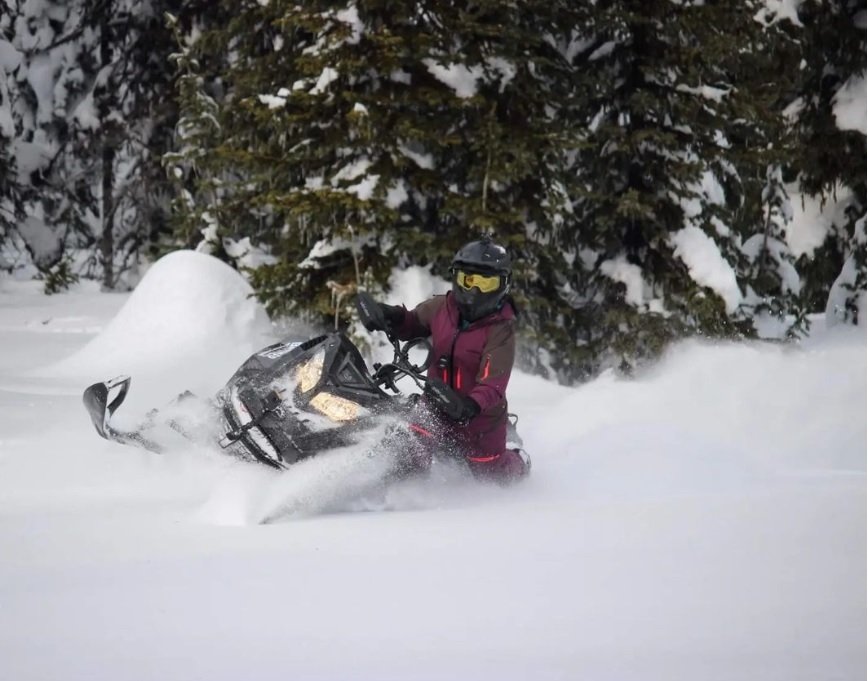BORN WITH A BROKEN HEART: HOW BC’S DOCTORS AND SLEDDING MENDED IT BACK TOGETHER
One in every 100 Canadian babies are born with Congenital Heart Disease. There is no cure. Congenital Heart Disease (CHD) is a problem in the structure of function of the heart that results in life long challenges. My name is Ashley Mckillop, I am a snowmobiler, and I was born with CHD.
As a baby I was the dream child that every parent hoped for; I slept a lot and was quiet. My records stated numerous times “patient appears healthy but is slightly agitated”. Some things never change, lol. Common symptoms of CHD include shortness of breath, tiring easily, swollen legs or arms and a rapid heart beat. At my six month check up it was determined that I had a Primum Atrial Septal Defect (a hole close to the tricuspid valve in the upper chamber of the heart), a closing Ventricular Septal Defect (a hole in the wall that separates the two lower chambers of the heart), and a leaky mitral valve that cause regurgitation of blood flow. The holes in my heart chambers caused the blood to move inefficiently, tiring my little body out. I was eventually tube fed, and then at one year old had my first open heart surgery to repair the ASD.
At seven years old I was healthy enough to have my second open heart surgery. Doctor’s replaced my mitral valve with a mechanical prosthetic valve that I should not outgrow. With my amazing luck, I was one of the unfortunate 4% that ended up in a complete heart block following surgery. The electrical impulses that were suppose to tell my heart when to beat were not passing between the top and bottom chambers of the heart. At the age where most children are learning to tie their shoes, I came out of surgery with my first pacemaker implanted to help control my heartbeat.
THE DOCTORS AND NURSES FIX OUR PHYSICAL SYMPTOMS AND AILMENTS; BUT NO ONE WARNS YOU ABOUT WHAT YOU WILL EXPERIENCE WITH YOUR MENTAL HEALTH OR HOW TO DEAL WITH THE POST TRAUMATIC STRESS.
Many patients who go through open heart surgeries and complications end up dealing with Post Traumatic Stress Disorder and anxiety. Over the years I have received professional support and have done the work to help heal that side of my body. My husband has played a huge roll in my journey and without him I wouldn’t be here today.
My first snowmobile was a blow up Ski-Doo in 1990. Eventually, My dad purchased a 250 Polaris for my sister and I when when we were around 7 and 9 - around the time of that first Pacemaker. It had a custom paint job so it sparkled pink when the sun hit the hood. After that, he would pick us up a new relic every couple of years until we eventually got a 2000 Summit. The yellow beast made us feel so badass. We went from a 340 Enticer to a 700 Ski-Doo Summit how couldn’t you?! As I got into my late teens I was busy doing teen stuff and didn’t ride much.
FOUR YEARS AGO I DECIDED IT WAS TIME TO GET BACK INTO SLEDDING. MY DOCTORS DIDN’T SEEM EXCITED AT THE PROSPECT AND ASKED ‘YOU REALIZE YOU ARE ON BLOOD THINNERS RIGHT?’
I responded with my usual ‘It beats sitting on the couch!’ I haven’t looked back. In fact, I joined the Kelowna Snowmobile Club Board of Directors and have learned A LOT. Understanding how the club runs has been a real eye opener on the time and dedication it takes to set the club up for each season and keep it going.
As difficult as this sport is, it has helped me feel free and not worry. When I am riding, it’s the only time my mind isn’t racing or worrying. In fact it’s the only time I feel calm and truly happy. It also keeps my heart as strong as it can be.
At the time of my diagnosis only 30% of those diagnosed with CHD survived into adulthood. I am here today to share my story and spread awareness. But most importantly, to also show you that no matter what your disease or illness is you can still do anything at your own pace.
I am still working daily to manage activity and mental health but I am grateful for my family, friends and medical team that have supported me along my journey. Sledding has been an outlet for my mind and the mountains are my home.
~ Keep on Tickin! xO
Words and photos by Ashley The Bionic
February is Heart Awareness Month. Congenital Heart Disease is the world’s leading birth defect. About 1 in 100 Canadian children are born with CHD. Learn more HERE.
On February 19th, 2022 the Kelowna Snowmobile Club took to the slopes to raise $29,723 for the BC Children’s Hospital Heart Center and Easter Seals BC/YK. Read more HERE.












